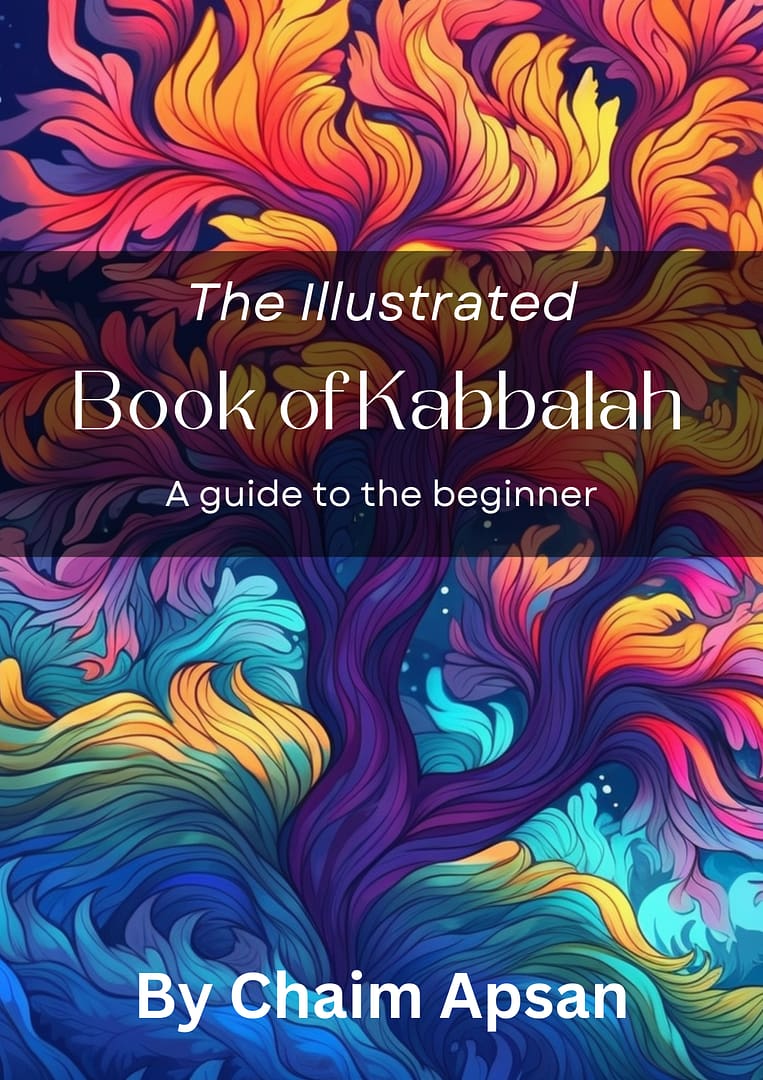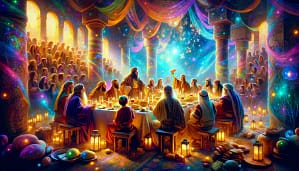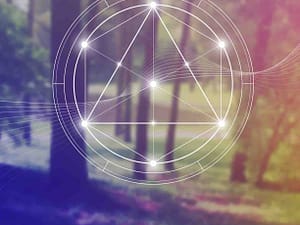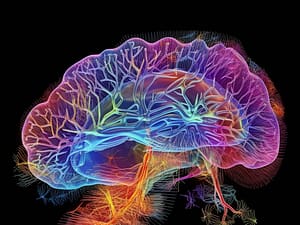Sefirat HaOmer is traditionally seen as a time for personal refinement, with each day maked by a specific combination of the Sefirot (divine emanations).
There are a lot of misconceptions regarding this period, so let’s learn a little about its holy Kabbalistic secrets. According to many commentators, Sefirat HaOmer encourages introspection and character development, mirroring the emotional and spiritual preparations the Israelites underwent before receiving the Torah on Shavuot. We know this is a period of 49 days in which we went from the 49th gate of Tumah (impurity) to the 50th gate of Kedusha (holiness).
And, of course, this is a period marked by anticipation, as it leads up to Shavuot, the 50th day, when the barley Omer offering in the Temple historically permitted the consumption of the new grain crop. This is not by chance, as Rebbe Nachman of Breslov teaches in Likutey Halachot that this represents a rectification of the Da’at, which is also an aspect of Shabbat, starting with the 2 barley offerings on the day after Pessach culminating with the 2 wheat offerings on Shavuot.

Contrary to beliefs, Sefirat HaOmer isn’t primarily a time of mourning. It is a time of a lot of Din (judgments) but also tremendous Kedusha as we will soon see. Yes, it includes somber remembrances, such as the passing of Rabbi Akiva’s students, which ceased on the 33rd day, known as Lag Ba’Omer.
While Lag Ba’Omer, the Hilula of Rabbi Shimon Bar Yochai is a festive day (which should be celebrated), this prompts the question posed by the Ramah of Pano: why would we possibly celebrate the fact that the students of Rabbi Akiva stopped dying? There was barely anyone left!
Clearly, we are talking about distinct events, as obviously the counting of the Omer preceded Rabbi Akiva and Rabbi Shimon Bar Yochai by many centuries. But we will get there later.
The restrictions of Sefirat HaOmer
In summary, most Poskim proscribe music and hair cutting. Some until Lag Baomer, and some even after, like Rabbi Shalom Sharabi (the Holy Rashash). The Ramban (Nachmanides) likens this period to an extended Chol HaMoed, emphasizing its importance in spiritual preparation, and makes a comparison to the 7 days of Sukkot.
The Rashash further teaches that this time profoundly influences how one is guided throughout the rest of the year, suggesting that our actions during these days resonate far beyond them. This is also the period in which the Mekavnim get a break and only use the Kavanot of Sefirat HaOmer.
The Rashash uses very strong terms against those that are Mekaven the regular Kavanot of the daily Tefilot and say they are in essence committing a big chillul (desecration), by bringing the Kodesh into the Chol. Essentially one is bringing great lights down when there’s no vessel to receive (akin to wasting seed) and this causes the Sitra Achra to gain power, especially in these critical times.
This is however subject to some debate among Mekubalim, and a few of them disagree. As far as I heard, the Kavanot of the meal and other regular Yichudim that can be used anytime are all permitted.
This is because during Pessach, Sefirat HaOmer and Shavuot we are operating on the Partzuf HaZemanim (the spiritual system of festivals), as opposed to the regular daily Partzuf HaYomi. Rachel (Malkhut of Atzilut) doesn’t go down to Beriyah, Yetzirah and Assiyah and as a result we only say Tikkun Leah, but not Tikkun Rachel.
The daily bracha (blessing) of Sefirat HaOmer rectifies the light’s Makif (“surrounding aspect”) with the innermost light revealed through prayers for the restoration of the Temple service (Yehi Ratzon) which we have in every Siddur.
Finally, during this period, we recite the prayer “Ana B’Koach,” which is meant to elevate the spiritual sparks that have descended throughout the time of the Omer. Some Sephardic communities also embrace the practice of reciting prayers composed by the Ben Ish Chai, who integrates numerical interpretations from the entire Tanach to correspond with each specific day of the Omer.
The Illumination of the Crown
The “Sifra D’Tzniuta,” or Book of Concealment, comprises five pivotal chapters within the Zohar that encapsulate incredibly deep Kabbalistic wisdom. Rashbi teaches that all the Torah is contained in these 5 chapters. In this text, he describes the Partzuf (spiritual system) of Arich Anpin of Atzilut, associated with the Sefira of Keter, as containing seven Tikkunim (Rectifications). These illuminations, particularly significant and seldom revealed, are revealed throughout the year.
Of these rectifications, the fifth, known as Ra’avah D’Ra’avin (“desire of desires”), is particularly known and is experienced on Shabbat after Mincha. The fourth Tikkun, Amar Nekeh (“clean wool”, which stays on the head of Arich), intriguingly relates to the word “Omer” (עומר), shows that the entire period of Sefirat HaOmer is a time illuminated by this specific Tikkun. It’s a powerful time.
This explains also the reason why R’ Akiva’s disciples died: as they all failed to honor, they caused a blemish on this Tikkun. This is also related to the Midrash where Moshe Rabbenu saw R’ Akiva as he inquired why Hashem was “putting crowns on the Torah letters”. The crowns are the “hairs” of the letters, corresponding to the hair of Arich Anpin, and so everything is connected.
The Kabbalistic interpretation extends to view all illuminations from the Sefira of Keter as expressions of pure compassion and divine oversight, affirming that Hashem’s rachamim is ever-present even in this time of Din.

More Kavanot for Sefirat HaOmer
Before we finish, let’s more on to some of the simpler Kavanot of Sefirat HaOmer.
The first is the 3 holy names of Hashem:
- EHYE (אהיה)
- The name YHVH (יהוה) with the MA”H (Gematria 45) expansion
- The name YHVH (יהוה) with the BE”N (Gematria 52) expansion
In this special period, we have 19 of each of those names to rectify. Each night of the Omer (up to the 40th), we need to have the Kavanah of rectifying a letter of these 3 names (rectifying 10 of each of them, because 4×10 = 40 days), while the last 9 full names are each rectified on each of the last 9 nights, as below:

This other Kavanah is similar, but we use 2 other holy names of Hashem, Ma”B of MA”H and of BE”N, which are essentially the miluy of the miluy (expansion of expansion) of each of them. For the second name of BE”N, we complete the remaining nights with the letter Vav, as shown below:

The Arizal taught Rabbi Chaim Vital to also recite Psalm 67 in the shape of the Menorah and it holds many awesome secrets. Taking out the introduction verse (which is put on the candles), there are 49 words. If you also count the middle branch, you will see there are 49 letters. So, as you might’ve guessed, we need to rectify one word and one letter (of the middle branch) each night.
There’s a Midrash that King David carved this very Psalm on his golden shield and when he would meditate on it, all his enemies would fall before him. It’s a very powerful Segulah for protection as many Mekubalim attest.
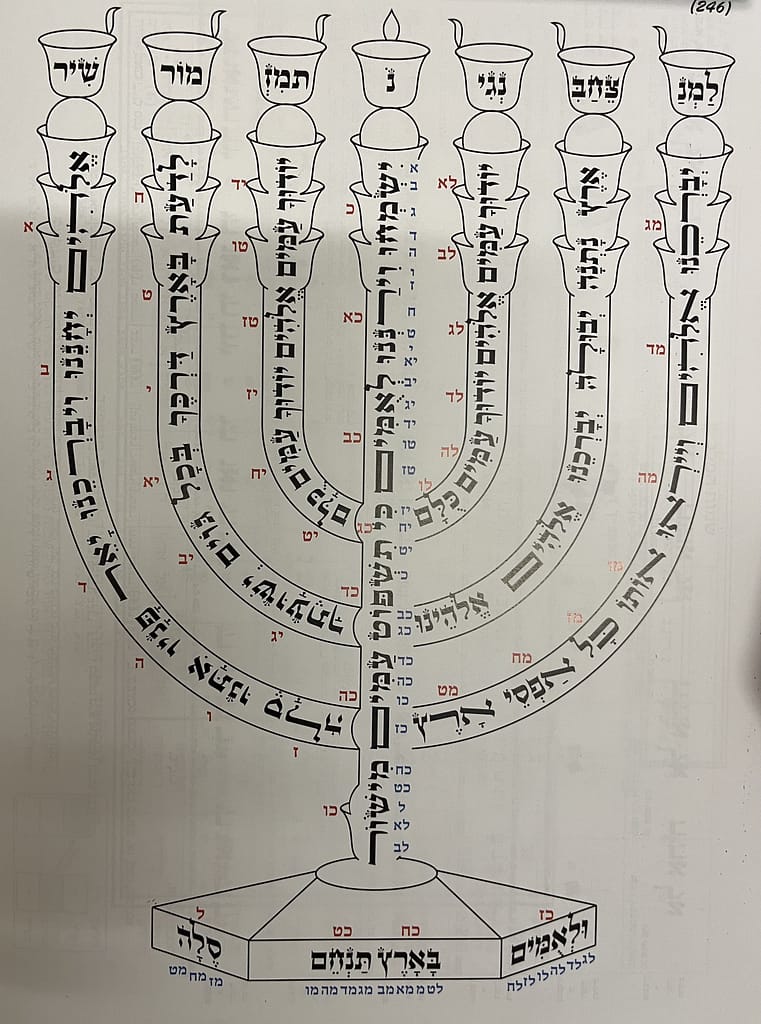
The Arizal also teaches to do the full Ana Bekoach prayer and also rectify one of its words and letters for each night. There are 7 verses with 6 letters each, which total 42 nights, but at the end of each week, we need to have the Kavanah to rectify the “generality” of the full verse (because, like in Gematria, the sum total of the parts working together is greater than the parts alone), so that makes it 7×7 =49.
On the 4th and 5th line of each verse, you will see the word and letter corresponding to the Psalm 67 of the Menorah which we just saw above:

Concluding Remarks
The journey through Sefirat HaOmer also involves navigating through seven systems of Din (judgments), each of which we strive to sweeten daily. Though this period may appear difficult, it is a time when, according to tradition, Hashem takes a more direct role in our purification.
This mirrors the transformation experienced by the Israelites upon their exodus from Egypt, offering us an opportunity for powerful spiritual growth and elevation. It is a very holy time indeed when the divine presence is particularly accessible as we prepare to re-accept the Torah on Shavuot.
As we engage with the myriad Kavanot and pursue our spiritual corrections during Sefirat HaOmer, let us aspire to reach the heightened spiritual states of Shavuot. May we all be blessed to complete our Tikkunim and merit the profoundly elevated lights of the upcoming festival.

